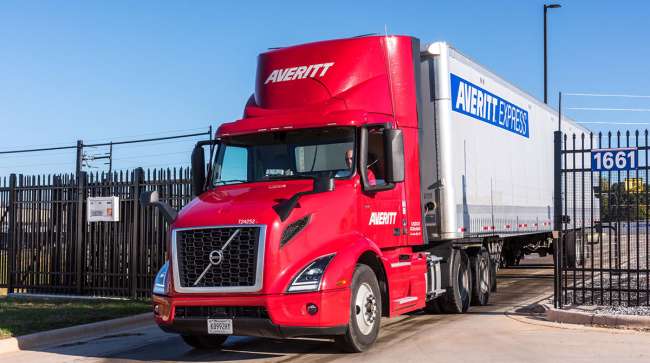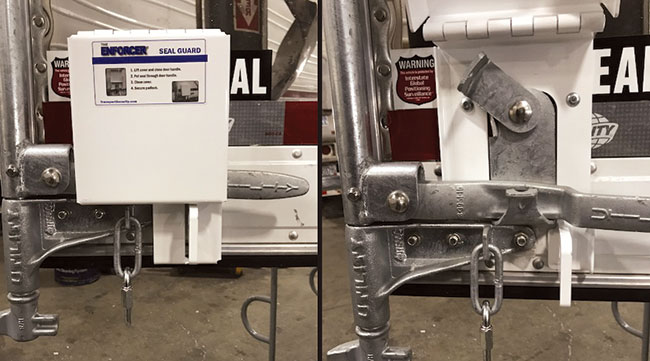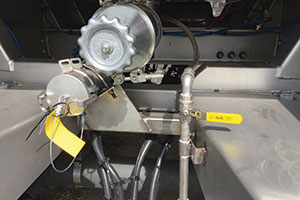Fleets Fight Increase in Cargo Theft With High- and Low-Tech Solutions

[Stay on top of transportation news: Get TTNews in your inbox.]
As if the trucking industry had not endured enough in the past year, 2020 also saw a substantial rise in cargo theft. To help curb this threat, fleets have been relying on a combination of technology and smart business practices to improve security and keep their drivers and loads safe.
“The safety of our drivers is No. 1. We don’t want them to put themselves in harm’s way,” said Melissa Jordan, freight claims supervisor at C.R. England. “The next priority is the customer and the integrity of their product.”
C.R. England ranks No. 26 on the Transport Topics Top 100 list of the largest for-hire carriers in North America.
Efforts to boost cargo security are becoming increasingly important as the risk rises.
CargoNet, a theft prevention and recovery network, recorded 1,676 supply chain risk events across the United States and Canada in 2020, a 16% increase from the previous year.
The costs associated with stolen cargo also have increased. CargoNet said the average theft was valued at $166,334 in 2020, up 19% from a year earlier. That increase was due in part to the stealing of expensive shipments of pharmaceuticals and medical supplies related to the COVID-19 pandemic.

Martino
Scott Martino, director of global intelligence for Senistech Inc., said large-scale pilferage has been on the rise for four years.
“Thieves use this as one way to gather intelligence on what is in trailers coming from certain distribution centers, etc., but they do sometimes have inside information of some form,” he said. “Thieves are opportunistic. They typically target specific cargo, but they will target anything if the opportunity presents itself.”
Fictitious pickups where perpetrators falsely claim to work for a carrier have become increasingly common in North America and Canada, said Tony Pelli, a supply chain risk consultant at BSI.
There have been cases of thieves successfully stealing a legitimate trucking company’s identity or taking on the name of a company that went out of business, Pelli said. A lot of this is done through phishing emails.
“They’ll say they’re a supplier who needs to get paid or a vendor who wants to pay them,” Pelli said, adding that it is vital to have a general awareness of cybersecurity.
At Averitt Express, multiple departments, including safety, security, operations and cargo claims, work in parallel to identify areas for improvement, said Tim Barnes, security coordinator for the Cookeville, Tenn.-based fleet.
Averitt ranks No. 32 on the for-hire TT100.
“At the same time, our team researches and tests new technology and tools that may enhance our ability to protect our assets and cargo,” he said.
Averitt uses various tools and technologies to fight cargo theft.

Barnes
“Asset-based tracking is the primary tool that can currently be used to increase recovery rates within the transportation industry,” Barnes said. “When we can pinpoint the location of an asset through GPS surveillance, we stand a good chance of recovering our assets.”
C.R. England also uses tracking technology.
“We’re able to see the location of any of our trucks or trailers in any given interval,” Jordan said, adding that tractors or trailers leaving their designated routes would raise alarm, and dispatch would contact drivers.
Some of the most effective measures aren’t new.
“It is always fun to talk about the cool new technologies, but it is the simple stuff that makes a difference,” BSI’s Pelli said.
Averitt’s Barnes said raising awareness among drivers and associates is one of the most important practices to reduce cargo theft risk.
“This includes conducting training around specific areas of cargo theft and promoting awareness campaigns through emails, newsletters, routine meetings and signage at facilities,” he said.
Averitt’s drivers and associates are required to participate in periodic training that focuses primarily on prevention, such as HM-232 security, which provides an awareness of security risks associated with hazardous materials, Barnes said.
Jordan said C.R. England conducts meetings with drivers regularly to discuss safety.
“We’re a teaching company as well as a trucking company,” she said. “From the beginning, drivers are taught about security and safety, and we have continued education.”
Once drivers are onboarded, they pay a deposit for Abus locks they use on every load.
“They’re a little thicker and require a diamond bit to get them off,” Jordan said.

C.R. England specs new trailers with Enforcer lock boxes, which are permanently mounted to the trailer. (C.R. England)
The Salt Lake City-based fleet prefers that drivers secure the locks on the right-side door, but sometimes the shipper’s security seal prevents that. To help avoid the issue, C.R. England specs new trailers with enforcer boxes that cover the latch and the security seal.
“It provides an additional place for them to place the padlock without damaging the seal,” Jordan said.
Enid, Okla.-based fleet Groendyke Transport specs all new trailers with welded rings on each side of any flanged connection and at each valve opening so drivers can secure a seal or cable lock, said Brian Gigoux, senior director of equipment and procurement.

Groendyke uses welded rings where drivers can secure locks, cargo ties or a numbered tag. (Groendyke Transport)
Groendyke also uses tags that have the same number as the freight bill. If the numbers don’t match or the tag has been removed, it reveals evidence of tampering.
Groendyke ranks No. 99 on the for-hire TT100.
Monitoring where thefts occur can help fleets determine the necessary security measures.
Such information enables fleets to take a more proactive stance on preventing theft, Sensitech’s Martino said.
California was the most common location for cargo thefts in 2020, accounting for 20% of all incidents, Martino said.
“Notably, although still ranked second, Texas jumped from 11% in 2019 to 18% in 2020 and was the most stolen from state in two of four quarters,” he added.
BSI’s Pelli said there are sophisticated crime rings in South Florida as well.
“If you’re doing a one-day drive or less than eight hours, there is low risk. Cross-country, cross-border journeys are higher risk,” Pelli said, adding that fleets also should examine geographic risk along the route.
“If you’re stopping in Memphis or Dallas or originating in Southern California,” he said, “there is higher risk.”
C.R. England tracks theft locations and advises drivers ahead of time if they’re entering a high-risk area.

Jordan
“We deliver some loads into the Bronx or Brooklyn. We know they have a limited amount of space to begin with, so it is easy to target those parking spaces that are available,” Jordan said.
She added that C.R. England reminds drivers to be aware of their surroundings when parking and find well-lit locations.
“We also ask them to back up to something — a wall or a light pole — so no one can open the door,” Jordan said.
Some customers with high-value loads take additional steps to strengthen security, such as requesting that drivers not stop within a certain distance.
“Depending on the value of the load, they may have pace cars that follow the truck,” Jordan said.
In 2020, truck stops, drop lots and public parking were the top reported locations where theft occurred, Martino said.
He suggested that drivers arrive at the pickup location fully fueled, fed, rested and with enough driving hours to travel for six hours. He also recommends drivers travel a minimum of 200 miles after pickup before stopping.
Want more news? Listen to today's daily briefing below or go here for more info:




